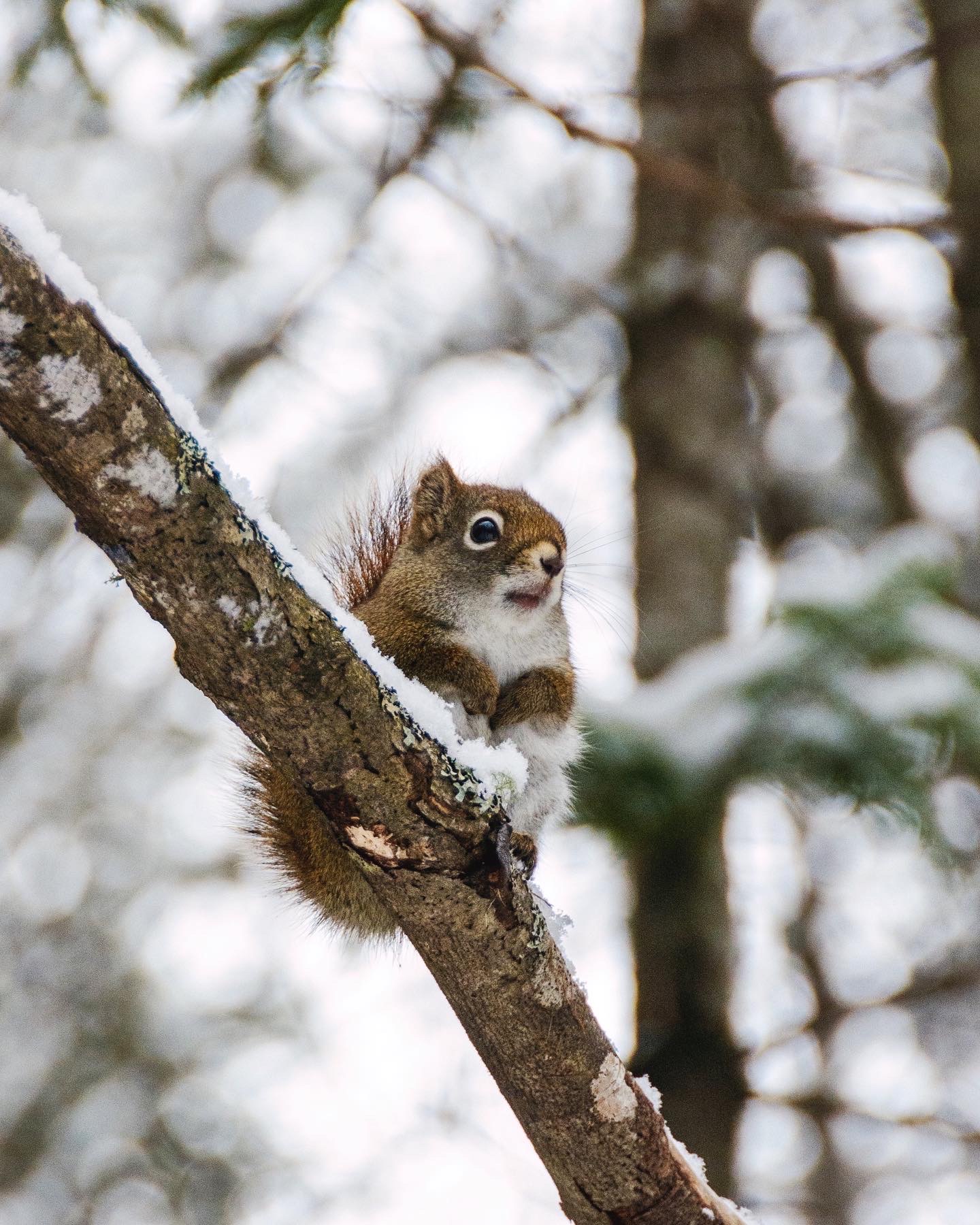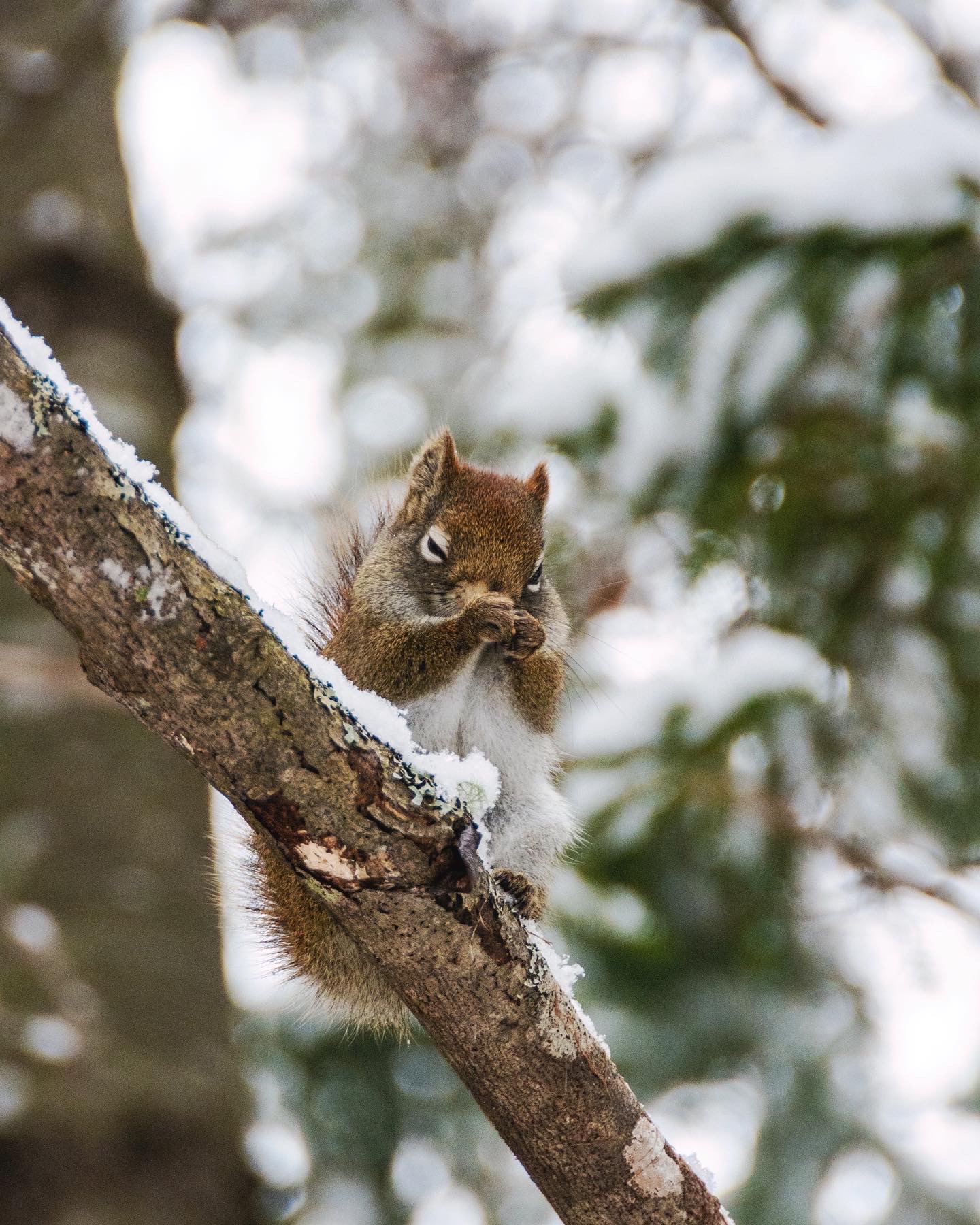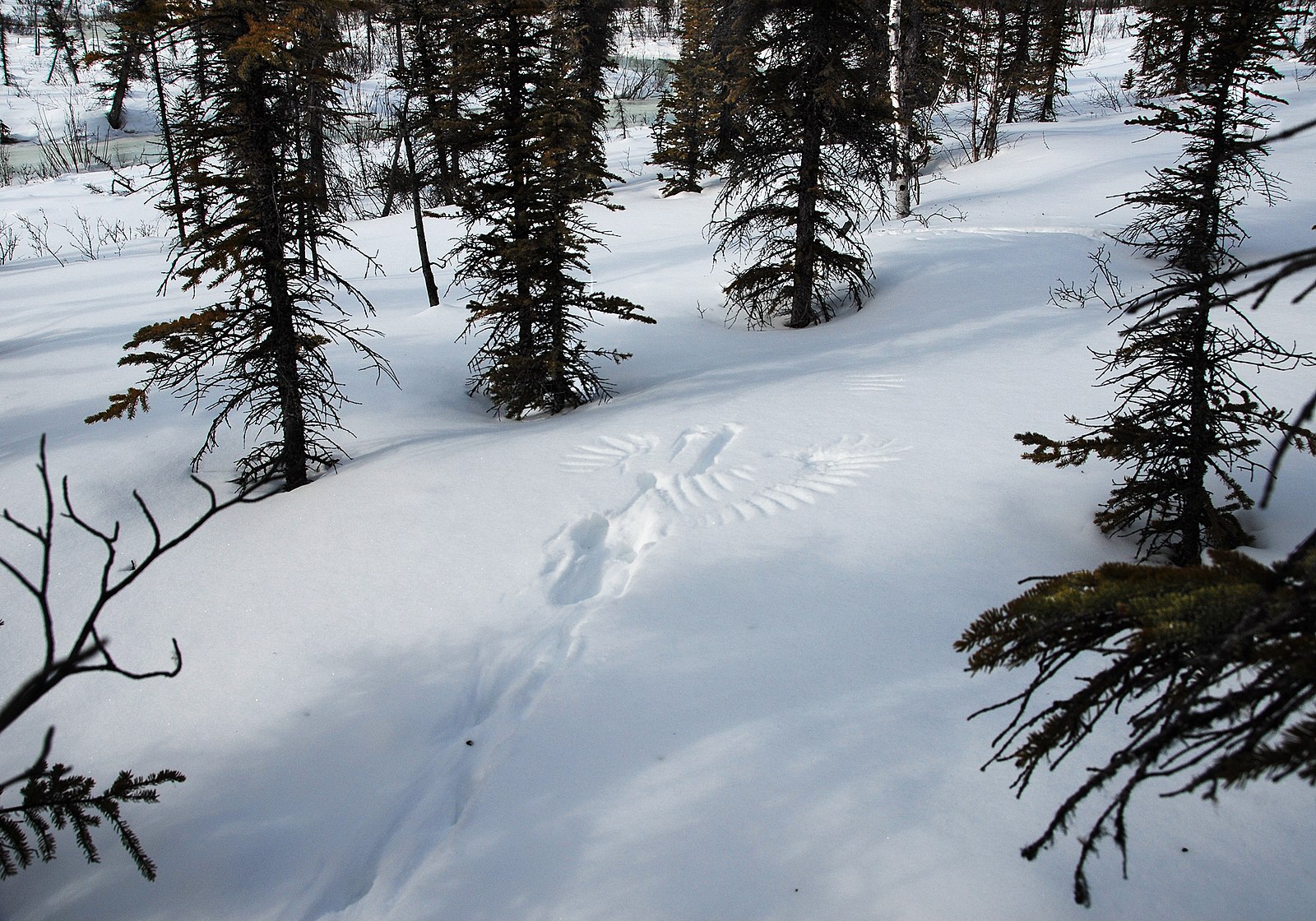Did you know there’s a hidden world beneath the snow where animals go to shelter from the frigid winter temperatures? It’s called the subnivean zone and it’s a region found beneath the snowpack in cold climates. It’s a unique habitat that is used by many animals, including mice, voles, martens, and squirrels. There are even some plants that can be found thriving in pockets beneath the snow.
This post is all about that hidden world: what animals shelter there, how you can find them, the dangers of living under the snow, and how scientists study this unseen world.


What is the Subnivean Zone?
The subnivean zone is formed when snow falls and accumulates on the ground. As the snow piles up, it generates a layer of insulation that captures the warmth from the ground beneath it. Heat from the ground then causes water vapour to rise through a process called sublimation. As the vapour cools and condenses, it turns into ice and forms a layer on the surface of the snowpack. This layer of ice provides additional insulation against the cold, allowing the temperature below the snowpack to remain around 0°C (32 °F), even in very cold weather.4
The subnivean zone is full of life. Small animals depend on the snow cover to survive frigid winter temperatures. Unlike large mammals, small animals tend to lose heat quickly in the cold because of their higher surface area-to-volume ratio.1 For a mouse or a vole, winter would be unbearable without the blanket of snow.
What Animals Shelter Under the Snow?
Animals that live, hunt, and shelter in the subnivean zone are able to do so thanks to a variety of adaptations. Some of the most common animals found in this habitat are voles, mice, shrews, red squirrels, and martens. Here’s a look at how they survive under the snow:
Voles
If they can avoid predation, voles thrive in the subnivean. By burrowing through the snowpack, they construct narrow tunnels that can extent for long distances. These tunnel systems can be quite elaborate and lead to food sources and dens where the animals can eat, rest and shelter. Tunnel systems also act as escape routes should a predator find its way inside.
Voles rarely have to leave the cover of the snow. During periods of inactivity, they huddle together to sleep and maintain warmth.2 They thrive in the subnivean by foraging for grasses, seeds, and bark. Tree farmers know this too well because of voles’ knack for girdling trees, which disrupts the flow of nutrients and can lead to tree death.3
Voles do not wait until spring to reproduce. They are able to have multiple litters during the winter months, due in part to the relative safety and comfort provided by the subnivean zone.4
Like voles, shrews and field mice also tunnel beneath the snow in the wintertime and survive on plants seeds, and bark.
North American Red Squirrels
During prolonged periods of heavy snowfall, North American red squirrels (Tamiasciurus hudsonicus) may spend most of their active time in the subnivean environment.5 The snow offers them protection from the cold and predators, and red squirrels are known to burrow in the snow to locate caches of stored food.
While red squirrels remain active through the winter, they may experience short periods of torpor.5 Torpor is a state of reduced physiological activity in an animal, characterized by lower body temperature, slower metabolism, and decreased physical activity. It is a way for animals to conserve energy when food is scarce or the environment is challenging.
Martens
Like voles and red squirrels, the subnivean offers martens (Martes americana) some protection from predators and the cold.6 Martens need physical structures on the ground, like snags and logs, to access the subnivean.7 Scientists have noticed that martens tend to enter the subnivean close to red squirrel middens.8
Martens also use the subnivean as hunting grounds. Voles are one of their most important sources of food.9 Martens can fit through some of the larger subnivean tunnels and snatch up voles.
Predation in the Subnivean Zone
While snow cover offers animals some protection from predators, the subnivean is not entirely safe from predation. Many animals have developed clever ways to find prey hidden under the snow. Owls, foxes, coyotes, weasles, and fishers are excellent subnivean hunters. In fact, animals living in the subnivean are a vital part of many larger mammals’ winter diets.
Great Grey Owl
The great grey owl (Strix nebulosa) uses its keen sense of hearing to find mice and voles hidden beneath the snow. Once the owl pinpoints their prey’s location, it swoops down, breaks the snow and grabs its prey.10 The resulting imprints in the snow often resemble beautiful snow angels.

Red Fox
Like the great grey owl, red foxes (Vulpes vulpes) use their sense of hearing to detect prey under the snow. You may have seen videos of them diving headfirst into the snow to grab prey. It’s awfully cute behaviour, but deadly for rodents! By pouncing onto the snow, red foxes can collapse the tunnels mice and voles use, trapping them inside.10 The deeper the snow, the harder it is for foxes to hunt this way.
Coyotes use similar hunting tactics to fetch prey hidden under the snow.
Ermine
Ermines (Mustela erminea) are small carnivorous mammals that belong to the weasel family. They are also called stoats or short-tailed weasels. The ermine’s slender body is small enough to fit through subnivean tunnels. Once in there, they use their sense of smell to find voles and mice.10 They are known for their agility and skill as hunters. Their fur turns white in the winter and helps camouflage them.
Fishers
Fishers (Pekania pennanti) are closely related to martens, but unlike the marten who can fit through subnivean tunnels, the fisher is too big. Instead, it must watch and wait for the animals to leave the safety of the snow. Once they do, fishers are quick and efficient hunters.
Other Subnivean Dangers
In addition to predation, there are other dangers that animals face in the subnivean. The collapse of snow tunnels can lead to the death of animals trapped inside, while broken tunnels or entrances can result in suffocation due to high levels of carbon dioxide.11 Additionally, early spring thaws can result in flooding, posing a drowning risk for animals. Despite these dangers, the subnivean remains the safest place for many small animals in the cold of winter.
Do Any Plants Live in the Subnivean Zone?
Some plants can also be found living in the subnivean environment. In fact, subnivean conditions are favourable to some plants, including hare’s-tail cottongrass (Eriophorum vaginatum), marsh Labrador tea (Rhododendron tomentosum), lingonberry (Vaccinium vitis-idaea), and Arctic bell-heather (Cassiope tetragona).12 Research has demonstrated that these hardy plants are able to succeed in the subnivean due to the favourable conditions, including elevated CO2 levels, sub-freezing temperatures, and sufficient light for photosynthesis.12

How Do I Know If There Are Animals Living Underneath the Snow?
The best way to determine if there is life beneath the snow is to look for evidence of animal activity. Animal tracks (voles, mice, martens, and red squirrels) can lead you to subnivean entrance tunnels. Next time you are out for a walk in a snowy forest or meadow, look for rodent tracks and tunnels.
How Do Human Activities Affect the Subnivean Zone?
That said, human activities (such as snowshoeing, skiing, or snowmobiling) can compress snowpack and collapse animal tunnels. This can trap animals, lead to suffocation, or make it more difficult for animals to escape prey. To help protect this unique habitat, it is important to be mindful of our actions and stick to trails whenever possible.
How Do Scientists Study the Subnivean Zone?
Scientists study the subnivean zone by observing and tracking the animals that live there. This can involve setting up cameras or other monitoring equipment to watch for animal activity, or tracking the movements of individual animals.
They also collect data on the temperature, moisture levels, and other environmental conditions within the habitat. This can involve using specialized equipment, such as thermometers and humidity sensors, to measure these conditions at different depths beneath the snowpack.
Conclusion
The subnivean zone is a unique and important habitat that is found beneath the snowpack in cold climates. It provides a warm and protected environment for a variety of animals. Many animals, both inhabitants of the subnivean and subnivean predators, could not survive the harsh winters without it. Scientists are also discovering the importance of the subnivean zone for some plant life.
Other Articles That You Might Like
Tree Lungwort (Lobaria pulmonaria)
Acadian Forest: History, Species, and Biodiversity
Nuthatches: The Birds That Walk Upside Down
Feeding Chickadees and Learning Their Curious Behaviour
Sources
1 Brian Rohrig. 2013. “Animal Survival in Extreme Temperatures.” ACS.
2 Julie Crick. “The Subnivean Zone, Life Under the Snow.” Michigan State University.
3 Ontario Ministry of Natural Resources. 1999. “Protecting Trees From Vole Damage.”
4 Heinrich, Bernt. 2009. Winter World: The Ingenuity of Animal Survival. HarperCollins.
5 John L. Koprowski. 2005. “Pine Squirrel (Tamiasciurus hudsonicus): A Technical Conservation Assessment.” USDA Forest Service.
6 McLaren, Fammond, and Thompson. 2013. “Characteristics of the Boreal Mixedwood Forest Associated With the Use of Subnivean Access Points by American Martens.” Ecoscience.
7 Stuart Shelburne. 1992. “Marten Use of Subnivean Access Points in Yellowstone National
Park, WyomingPark, Wyoming.” Utah State University Graduate Thesis.
8 Stuart Shelburne. 1993. “Squirrel Middens Influence Marten (Martes americana) Use of Subnivean access Points.” The American Midland Naturalist.
9 Roger Powell, Steven Buskirk, William Zielinski. 2003. “Fisher and Marten” in Wild Mammals of North America: Biology, Management, and Conservation.
10 The Nature of Things. 2018. “The Wild Canadian Year: Winter.” CBC Docs.
11 Gretchen Kehrberg. 2020. “Beneath The Snow, The Subnivean Zone Bustles.” Montana Public Radio.
12 Gregory Starr and Steven Oberbauer. 2003. “Photosynthesis of Arctic Evergreens Under Snow: Implications for Tundra Ecosystem Balance.” Ecological Society of America.